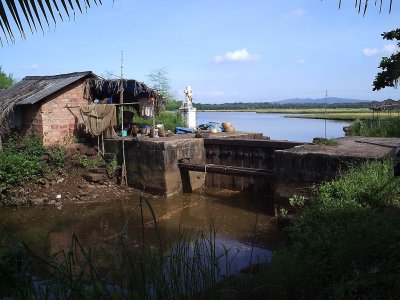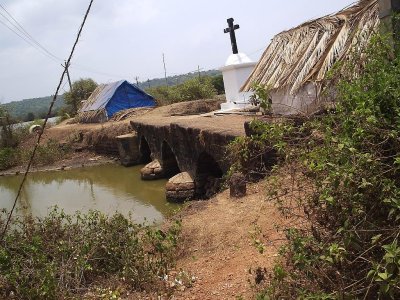by Sangeeta Sonak
All photos by the author.

Khazans are coastal wetlands of Goa. They were reclaimed from mangrove forests, probably in the pre-Christian era by an intricate system of dykes, sluice gates and canals and put to multiple productive uses such as agriculture, aquaculture and salt panning. The first documentation of khazans is in the sixth century AD, which is a donation of a khazan land by a king on a copper plate.The khazan ecosystem is an integrated system, initially with major emphasis on agriculture.
Expenses for maintenance were met through leasing of cultivation and fishing rights. However, with changes in the global economy and market, aquaculture has become the main activity of khazans now. Some of the khazans are used only for aquaculture now and remain uncultivated otherwise but some are still used as paddy fields in monsoons.

Traditional Khazan technology protects agricultural fields and villages from salinity intrusion, inundation and floods.
Khazan dykes are built of mud from fields. Outer walls or protective dykes are very thick to sustain pressure of riverine water flow. A trench (chanoy) is made in between the two walls of the protective dyke and is filled with clay from the fields, which serves as a cementing substance. The dyke is covered with a layer of clay and mud from fields, called as tharcupto. Protective dykes are interrupted by installation of sluice gates, which connect an inner reservoir to the estuary.
 Sluice gates regulate water fluxes allowing sufficient water in the fields, but preventing inundation of khazan lands. Sluice gate shutters close automatically during high tide allowing only a part of water inside. During low tide, they open to let water go out. These shutters can be manually manipulated to get required quantity of water inside the fields.
Sluice gates regulate water fluxes allowing sufficient water in the fields, but preventing inundation of khazan lands. Sluice gate shutters close automatically during high tide allowing only a part of water inside. During low tide, they open to let water go out. These shutters can be manually manipulated to get required quantity of water inside the fields.








